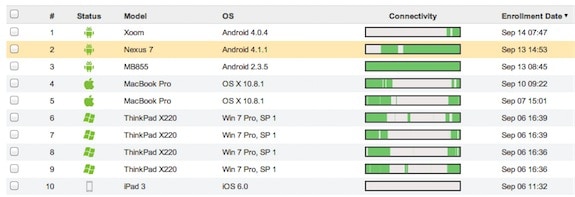We took some time to chat with some IT directors and found some research showing that,
- 60 percent of IT professionals believe 25 percent or less of their employees are accessing work related information on their smartphone or tablet.
- 57 percent of users said they access work related information on their smartphone or tablet at least once a week.
It became clear that a BYOD/mobile policy is becoming a necessity and should have the following elements:
- Set of expectations that align with your organization’s goals
- Clear and plain language
- Concise, so that everyone reads it
- Tools to enforce (Mobile Device Management)
Mobile Expectations
You want the most out of all of your employees and the best way to do that is to let them know exactly what you expect. Many employees are not privy to the overarching strategy of an organization and feel that their efforts are lost in the shuffle, as are their desires and need for work-life balance. Explaining how mobile devices fit into the corporate culture and goals of the organization will provide guidelines for their use within day-to-day operations. Your employees will appreciate being allowed to stay connected to their families and personal lives.Clear and Plain Language
“Thou shall not pass”, Gandalf can get away with such words, but a mobile policy that is going to be understood should be written with plain English and not legalese. When was the last time you actually read the user agreement license on a new piece of software? (Well, you’re the head of IT, so probably always, but the majority of employees won’t.) So keep the language simple and clear. Using normal conversational vernacular will suffice.Concise
One of our favorite mottos is KISS “Keep It Simple Stupid”. A mobile policy over 2 pages is probably pushing it. Remember, this is a document that should be a guideline for usage, not document every possible scenario (which is impossible, because that time the rhino came into the company bathroom to use their cell phone for a personal call, was not foreseeable...and not true, but you get the picture). Also, 11pt font single spaced makes our eyes cross and causes vertigo (not really, but it is hard to read) and we want everyone to read the new policy. If the entire policy can fit on a single page, great. If not, don’t go over 2 pages. We all have work to do.What Not To Include
Policies already sound like a proverbial “ball and chain” and when approaching it employees will cringe thinking that management is going to restrict usage again or impose some arcane security requirement, or ban use all-together. When approaching your mobile policy, do not include the security policy or write an entirely new one. You’ve already got one and to keep it easy all you have to do is make sure the policy fits within it.Mobile Device Management Tools
Sometimes its not enough to just have a policy; you want to sleep more soundly. Finding the right tool can be hard. You want to improve productivity, but you do want to keep data safe while keeping up morale. When evaluating an MDM be sure that it covers all types of devices, Mac PC, Android iOS, etc, provides network analysis, scales with your business, supports BYOD (if you’re not supplying mobile devices), links ties in with business reporting, and supports content management.Newmind Group device management clients benefit from these features, but if you're not ready to make the jump to such a robust tool, try the lighter Meraki Mobile Device Management platform. It will monitor multiple device types, from iPads and Androids to Macs and PCs, and even monitor recent locations, and allow administrators to lock and erase devices, among other great features.
 |
| Meraki Mobile Device Management device list and connectivity. |
Those are just 2 of the many tools available to help make your workforce mobile, collaborative, productive and secure.
Now go forth and create your mobile & BYOD policies. Remember to keep them short & clear, with easy to digest expectations that fit within your current security policy and you’ll be one step closer to a more connected & efficient workforce.


No comments:
Post a Comment